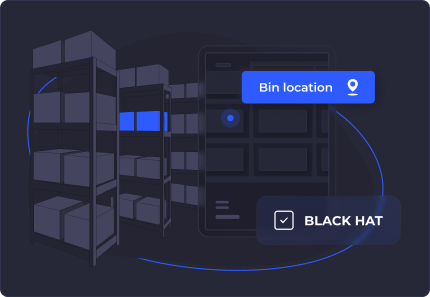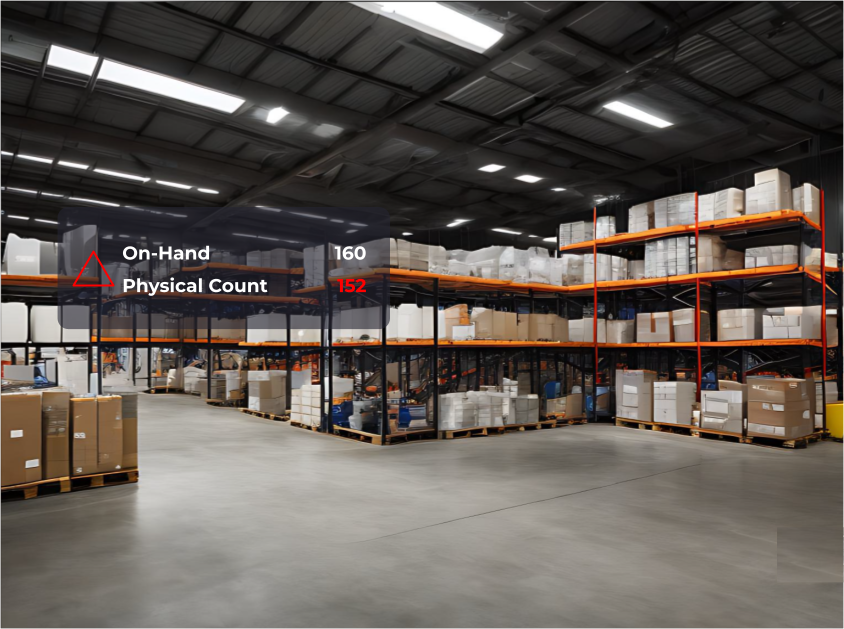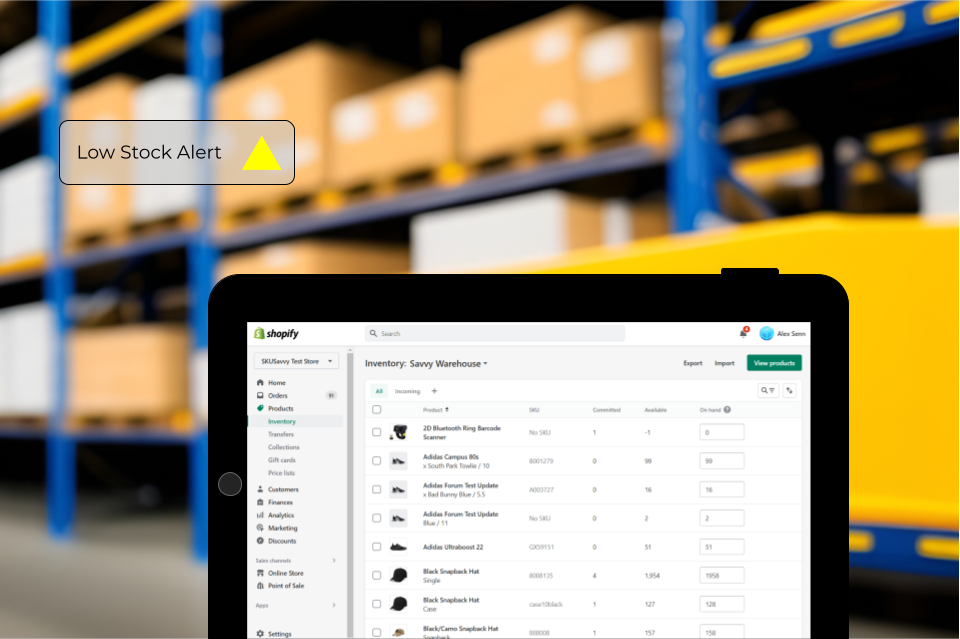Inventory Management Optimization Introduction
Alex
2/26/2022
Inventory management optimization metrics help get an in-depth look at the efficiency of your fulfillment center by making use of key data to convey the trends which are of utmost importance. Such metrics are essential to operators as they reveal details about the efficiency of the warehouse that will guide them into making positive decisions for continuous improvement. These choices can range from inventory level adjustments and back stock decisions to order cycle time and on-time deliveries, all of which provide significant information when it comes to constant refinement and restructuring of procedures.
To maintain continuous improvement it's a good idea to keep your eye on the prize. Using a goal-setting approach such as SMART goals, which stand for Specific, Measurable, Attainable, Relevant, and Timely. Using this approach or something that works for you will enable you to keep the high-level objectives in clear view while using the metrics and optimization tactics to get you there. In our experience, it's easiest to make continuous improvement possible when you select just one or two primary goals you want to achieve before moving on to other goals in your warehouse.
Solid metrics and good team collaboration can help companies improve on-time deliveries, increase customer satisfaction, and reduce operating costs among other things. To achieve these wins, there are certain aspects that need to be evaluated carefully prior to picking the KPIs that matter to you. These are:
Even though a KPI can capture efficiency, it is harder to chose the ones that increase in effectiveness
Make sure that the KPIs have a narrow scope to avoid the ones that will not give insights into the areas where the action is needed
Close the ones that amplify and reward collaboration towards achieving common strategic objectives
Ensure that the inventory KPI dashboard can be configured according to your preferences
The adequate use of KPIs can facilitate the process of translating operational performance into financial reporting across the inventory management system and ultimately improve production and purchasing processes, cash flow, and profitability. Some of the inventory management optimization KPIs that better match the fulfillment center are listed below:
Demand Forecast Accuracy
Customer Satisfaction Level
Perfect Order Performance
Fill Rate Effectiveness
Gross Contribution Margins
Order Cycle Time
Order Accuracy
Inventory Turnover
Carrying Cost of Inventory
Supplier Quality Index
Inventory management can be an intimidating task as the results tend to impact every single area of the business. Some of the most common challenges are:
Inconsistent Tracking: Manual inventory tracking is time-consuming, redundant, and vulnerable to errors. This is why having a proper centralized tracking system like SKUSavvy with metrics readily available could be the smartest move
Warehouse Efficiency: Inventory management controls are labor-intensive as they involve put-away, replenishment, picking, packing, and shipping. Efficiency is the key challenge
Inaccurate Data: Knowing what inventory is available and where it is at any given point in time is a necessity in modern warehousing dynamics
Changing Demand: As customer demand is constantly changing, it is essential to have a strategy in place for core items along with technology to create and execute an inventory plan
Limited Visibility: Having an unidentifiable inventory can lead to incomplete, inaccurate, or delayed shipments. Therefore, tracking localization is vital to efficient operations and a positive customer experience
Supply Chain Complexity: An ever-changing global supply chain requires flexibility and the ability to deal with unpredictable lead times
Managing Warehouse Space: Planning and designing warehouse spaces helps to better control the timing of new stock deliveries and calculate spacing correctly
Insufficient Order Management: Preventing overselling some products and running out of inventory is a real challenge, therefore analyzing seasonal trends can help to predict customer orders.
Increasing Competition: Competition for raw materials is impacted by unpredictable economic shifts and market forces, so businesses either compete for high demand materials or hold inventory to control costs
Inventory Loss: A loss in inventory due to spoilage, damage, or theft requires identifying, tracking, and measuring different problems areas
Poor Production Planning: Production planning is vital to avoid delayed manufacturing and cost overruns which can ultimately impact sales forecast and project scheduling
Lack of Expertise: Inventory managers need to be adept at the latest technology such as SKUSavvy in order to improve inventory strategy, simply upgrading the inventory management platform will not suffice
Poor Communication: Communication and collaboration are key to finding inventory trends and areas of improvement
Inefficient Processes: Sales volume increases and inventory expansions often push inefficient, labor-intensive, and low-tech standard procedures to change the order to allow for adequate scaling.
Inadequate Software: Modern software is imperative to support complex logistics and needs to integrate with your existing business process platforms. Choosing the right solutions with the features you require is paramount to success long-term
A primary purpose of inventory management is to aid companies in saving money by ensuring supply meets the demand for their products/services. Some clear advantages to having a proper system set-up are:
Better Inventory Accuracy: Know what amount of inventory more closely matched demand
Reduced risk of Overselling: Balancing in-stock and back-order amounts is key when trying to avoid an oversell
Cost Savings: Carrying only the necessary inventory will prevent extra costs such as storage, handling & transportation fees, insurance and salaries, theft, and even loss from natural disasters
Avoiding Stock Outs and Excess Stock: Helps businesses minimize the number of days that items are out of stock and to avoid carrying too much inventory for sales
Greater Insights: Easily spot sales trends or track recalled products
Better terms with Vendors and Suppliers: Having insights about which products sell and what specific volume, then there should be enough leverage to negotiate better prices and terms with suppliers
More Productivity: Save time that could be spent on other activities
Increased Profits: A better understanding of availability and demand leads to higher inventory turnover which then leads to greater profits
More Organized Warehouse: Organize items by demand level using bulk methods for similar items in order to reduce labor costs and increase fulfillment speed
Better Customer Experience: Promote customer loyalty by guaranteeing on-time delivery
Running a successful inventory management system requires adequate hardware that can assure the proper deployment and functioning of the respective software. Today the hardware requirements are not so much the servers and computers as it is the devices to run the software on like smartphones and tablets. This is how it's done on SKUSavvy. Using an on-premise system comes with a variety of challenges. So the cloud-based platforms have risen to become superior in cost and set-up complexity level.
There are several other requirements that will need to be checked out prior to setting up a customized inventory management system. These are:
Upgraded server infrastructure or cloud/hybrid capability that will enable many employees to access the system simultaneously with near real-time data
When running a browser-based app the preference should be toward Google Chrome, Safari, or Mozilla
A tablet can be used as a portable solution to manage inventory, especially with cloud-based options - this will require either browser access or an app from the app store to utilize
Have a stable and speedy internet connection with enough routers to provide the proper amount of wireless coverage throughout the whole warehouse - look at utilizing WIFI extenders
For older applications, you may be required to utilize a barcode scanner - with newer applications like SKUSavvy you can utilize any device camera to scan up to 20 barcode formats
Some of the most common barcode formats that a system will need to print the labels are: EAN-13, UPC-A, EAN-8, Code 128
Own the onboarding process by explaining individual needs and workflows to the onboarding specialist so that later he can give targeted advice to newcomers on how to achieve the goals using the system
Using SAAS as the main system for cloud-based inventory management will help avoid setting up expensive elements like your own data security and web hosting framework
Cloud-based solutions can take around 1 month before being able to go live and takes 2 months for onboarding
Before going live, it is essential that: product data must be correctly set up, customer data then needs to be uploaded, adjust system settings, and ensure connections are tested
In terms of integration for eCommerce and where money is best spent, online reach has increased drastically in the past 5 years. It's become an essential pairing for the inventory management system to connect with multiple eCommerce platforms. This requires inventory management systems to be integrated with the eCommerce platform so that real-time inventory updates are pushed through to your eCommerce store to facilitate accurate inventory availability. The integration populates the order details into a sales order and then this is fulfilled via the inventory management system. Common inventory management systems include:
Shopify
Amazon
Magento
BigCommerce
WooCommerce
Adobe
There are four main software requirements for inventory solutions:
Stock Management: Use this feature to control both the stock at hand and the stock value
Unlimited Usage: Although systems with a usage cap can be cheaper, it is not recommendable for handling large amounts of product
Reorder points and low stock alerts: Users are able to set up reorder points based on order volume and lead time based on system data
Reporting: As depth and customizability can vary greatly from customer to customer, it is important to pick the right report. Some of the most common are stock movements, inventory on-hand, purchasing, and fulfillment reports
When dealing with supply chain strategy, inventory management optimization plays a crucial role as it can push owners to select the correct software that can aid their business operability. As different businesses have different needs, making a requirement list can ensure that the product chosen is indeed the right fit in terms of efficiently encompassing the many facets of the process including production, warehouse management, accounting, sales, and purchasing, among others.
The main features that will enable inventory management optimization are:
Inventory Management: Ensures centralization of warehouse functions where data is synced to allow for same information access which enhances team collaboration. It also gives way to Vendor Managed Inventory (VMI) as it is a solution to long-term business relationships which lets your vendor handle recurring deliveries. In addition, automatic shortage reports can help owners address issues related to inventory mishaps as quickly as possible. Ultimately, this management system helps with potential issues related to product categorization, product measurement, product history, stock inquiries, cycle counting, among others.
Inventory Tracking: Inventory can be tracked by serial numbers, RFID tags, barcodes, and other IDs. This is essential for inventory auditing, especially when it comes to perishables or consumables as they can perish which will require recalling. Tracking can facilitate and optimize pick and putaway processes, therefore reducing purposeless movement which improves productivity and cuts labor costs. This system allows for the correct functioning of product tracking, inventory tagging, and audit trail
Transfer Management: Having multiple sites is key to successfully bundling products in order to attract customers, especially during some seasons. Transfer management allows for inventory tracking, including systems like pick-to-light and voice picking to facilitate the process to help owners guide and direct their workforce. This allows for multi-location tracking, stock transfer, order picking, product bundling, voice picking, among others.
Purchasing: Relates to creating and managing purchase orders (POs) where items can be added through barcode scanners. It mostly consists of receiving partial orders and tracking backorders. Some of the main aspects that it covers include purchase orders, supplier management, backorders, among others.
Shipping: Automation is a keyword here and will certainly help customers reduce the number of errors significantly, mostly related to late deliveries and incorrect packaging. There is the possibility to dispatch orders as multiple shipments, therefore making sure that customers receive in-stock goods the fastest way possible. Some of the most important aspects within shipping are: labeling, multi-carrier shipping, shipment by ID, among others.
Order Management: With this system, users can customize pricing, send quotes, track orders, and manage returns. As an essential feature for maintaining customer satisfaction, it comes with the following elements: order tracking, quotations, multichannel sales, among others
Reporting and Analytics: Analytic tools help evaluate patterns in the process to forecast future demand and sales which can in consequence leverage safety stock and carrying costs while preventing stock outages. Reports make this data easier to understand and digest by allowing for a clean display of insights. Some of the most substantial pieces that this area touches are: dashboards, customized reports, report generation, drill-downs, among others.
Deployment: Due to the fact that not every system offers both deployment methods, cloud-based products are generally picked over on-premise as they typically have fewer sunk costs, offer better visibility, and maintain backup of your data. The most popular cloud-based deployment methods are SaaS, Paas, and IaaS.
Mobile Support: Systems offering mobile sites enables users to access the system from any desktop through the use of tables, phones, and other mobile devices. As mobile support is often OS specific, users need to be mindful and make sure that their inventory app works with their existing hardware.
Integration: Integrating supply chain systems, CRM, and eCommerce platforms could enable having central control of the business software, a huge advantage for core activities.
Inventory management costs relate to the price of doing business which may vary from 10% to 40% of the inventory value. Such costs need to be managed when dealing with purchases and logistics. There are three main inventory management costs:
Inventory Ordering Costs: Incurred in ordering a batch, production run, or purchase of externally made parts or products. This category usually includes order approval and administration costs as well.
Inventory Holding Costs: Incurred when holding inventory in storage and managing its delivery to customers. These are easily quantifiable and include: warehouse and logistics costs, insurance, spoilage, write-offs, and opportunity cost.
Inventory Shortage Costs: Refer to the cost of running out of stock and being unable to supply customers with the requested goods within a specific timeframe. The direct effects of stock shortage mainly relate to lost sales and profits, lost customers, stock-out fines, and contract disputes.
Start Trial
A New Way to Warehouse: Visual Warehouse & Inventory Management System





